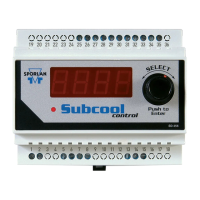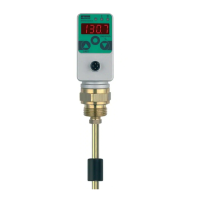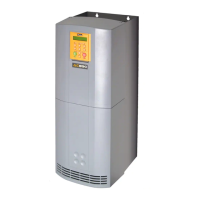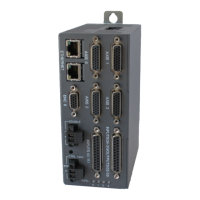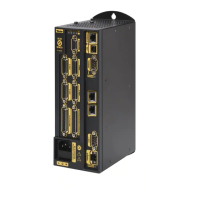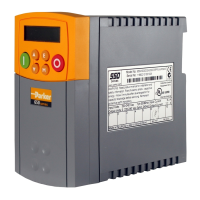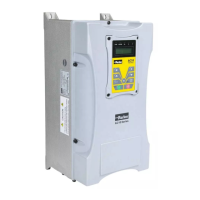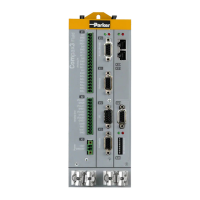Bulletin 100-50-9.1 – Page 103
5. Press the ▼ button until f, (fan configuration) is
displayed, press SET.
6. The display will show (fan control type); press
SET.
7. Press the ▼ button to scroll to 1d(one speed); press
SET. This will set the system to single speed fans.
8. The display will show , press the ▼ button, scroll to
U (fan current baseline); press SET.
9. Use the ▲▼ buttons to enter the case fan current, in
Amps, then press SET. This should be the design fan
current (include all fans in the case). For example:
if one case has four fans and each fan operates at
800mA, then U should be set at 3.2A (800mA X
4). Note: If this setting is not entered, the S3C
will automatically calculate this value based on
actual run time data.
10. The display will show U, press the ▼ button, scroll to
(fan fault enabled); press SET.
11. Scroll to o to turn off the fault feature, scroll to e to
keep it active; press SET.
12. The display will show N, press the ▼ button, scroll to
(fan fault sensitivity); press SET.
13. Use the ▲▼ buttons to enter fault sensitivity, in mA,
then press SET. The sensitivity is the amount of current
the bank of fans can drop before a fault is presented. For
example: If U is set to 3.2A and is set to 120mA,
then a fault condition will occur when the current drops
to 3.08A (3.2A – 0.120A).
14. The display will show , press the ▼ button, scroll to
d (fan fault delay time); press SET.
15. Use the ▲▼ buttons to enter fault delay time, in
minutes, then press SET. The fault delay time is the
amount of time the controller waits before sending out
a fault alert.
16. Press the ESC button three times to exit the menu and
return to the default display.
11.9.1 EVAPORATOR FAN CURRENT SENSING
The S3C Case Control offers evaporator fan fault detection
to aid in troubleshooting for cases that use ECM and shaded
poll motors. The fan current baseline may be manually
entered by setting the parameter fU (Fan Fault Current
Baseline). If this parameter is not set, the controller will
automatically establish a baseline current using system
run time information within the first 24 hours of operation.
An alarm will be generated when the fan current drops
below the baseline. This feature may be disabled by setting
N (Fan Fault Detection Enabled) to No.
It is important to ensure all fan circuitry is wired correctly
and fan loads are within expectations of the case prior to
start up.
Note: If the fans are replaced after operation, it is
necessary to reset the baseline. See Service section
for more details. The Service section will also provide
details on how to manually initiate fan operation and
check for proper operation.
11.10 NETWORK CONFIGURATION
The S3C Case Control system must be configured to
properly communicate to the BAS. The controller offers the
following communication options:
1. BACnet/IP (Ethernet)
2. BACnet MSTP (RS-485)
3. MODBUS UDP/IP (Ethernet)
4. MODBUS RTU (RS-485)
Follow the procedure below to set-up and configure the
case controller network settings. For more information, see
Network and Communication Section 21.
Note: Ensure that the S3C control is configured to
match the requirements of the BAS and network
design.
1. From the default display, press the button. e
display will show .
2. Use the ▲▼ buttons to enter the administrator
password and press SET.
3. e display will show (will skip to Process Values
if system is self-contained).
4. Press the SET button and (Process Values) will be
displayed.
5. Press the ▼ button until e (Network Conguration)
is showing, then press SET.
6. Using the chart below, scroll thru and congure
the controller to match the BAS and network
requirements.
Display Description Range
f
Fan control type
Variable speed ( )
Dual speed ( )
Single speed ( )
U
Fan fault current baseline .12 to 6A
Fan fault detection enabled No or yes
Fan fault sensitivity 120 to 500mA
d
Fan fault delay time 0 to 100 minutes
d
Fan speed low setpoint 0 to 99%
d
Fan speed high setpoint 1 to 100%
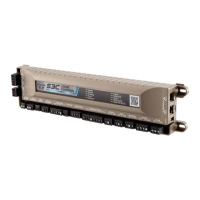
